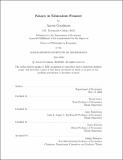Essays in Education Finance
Author(s)
Goodman, Aaron
DownloadThesis PDF (1.374Mb)
Advisor
Autor, David
Finkelstein, Amy
Poterba, James
Terms of use
Metadata
Show full item recordAbstract
This thesis consists of three chapters on education finance. I examine the funding systems that support public education provision in the United States, consider the incentives and constraints facing government actors within those systems, and identify policy interventions with the potential to allocate public funds more efficiently and improve student outcomes. The first chapter discusses financial aid policy in the higher education setting, while the second and third chapters study state and local financing of primary and secondary schools.
The first chapter investigates how the geographic fragmentation of the American higher education structure shapes financial aid policy. In particular, I present theoretical and empirical evidence that competition between state-controlled university systems causes socially costly distortions to the allocation of financial aid among undergraduate students. In a tractable model, I demonstrate that business-stealing incentives lead states to provide less need-based and more merit-based aid than a national planner. Measuring competition from out-of-state institutions with both geographic distance and time-varying university rankings, I validate the model and show that a heightened threat of student outmigration shifts aid dollars away from need-based grants and low-income families. Quantitatively, need-based aid awards would be 27% larger, merit-based aid awards 14% smaller, and low-income college-attendance rates 8 percentage points higher under optimal policy.
The second chapter considers intergovernmental fiscal relations in public school finance, where K-12 school districts rely on both funding from state governments and their own local tax collection. The dual nature of K-12 education funding complicates the analysis of school finance policy, since districts can adjust their local revenue collection in response to state funding changes and use accumulated savings buffers to divorce spending choices from current revenue levels. Focusing on the helpful institutional setting in the state of Ohio, I address this challenge and develop a method to evaluate the long-run consequences of state-level funding reforms. I first build a dynamic model of school district financial behavior and validate its reduced-form predictions about levy-proposal and spending-saving decisions. I then estimate the model, leveraging the large amount of annual variation in districts' financial resources caused by historical volatility in state aid and a unique state law freezing the nominal value of local property tax revenue. The structural estimates allow me to simulate individual districts' reactions to state funding changes and compute the resulting spending and welfare effects of counterfactual policy reforms. Differences in districts' estimated preferences and initial financial conditions create substantial heterogeneity in the behavioral responses that determine the ultimate pass-through effect of state funding changes on spending levels. By targeting districts with the most favorable behavioral responses and the highest valuations of marginal funds, budget-neutral reallocations of state aid can attain welfare increases equal to 4% of Ohio's current education expenditures.
The third chapter examines how the distribution of school districts' property wealth affects their ability to raise local education funding. Using administrative data on individual property values, I document substantial household heterogeneity within Ohio school districts, in contrast to the perfect sorting generated by canonical Tiebout models. I show that the composition, dispersion, and shape of intra-district property value distributions have important effects on the vote shares of property tax levies and on districts' resulting revenue and spending levels. Nearly a third of Ohio's school districts have exercised the state's unique option to implement local income taxes, again contradicting theoretical results about the optimality of zero local income taxation. Districts that choose to use income taxes appear to do so because income taxes distribute the local tax burden more efficiently than comparable property taxes, allowing revenue and spending levels to rise.
Date issued
2022-05Department
Massachusetts Institute of Technology. Department of EconomicsPublisher
Massachusetts Institute of Technology